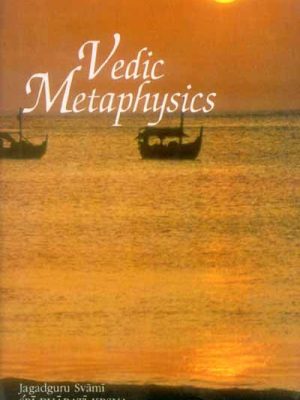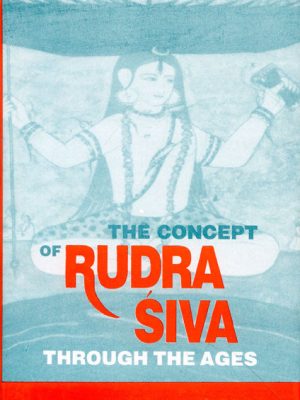Featured Books
-
Vedic Metaphysics
Vedic Metaphysics
In 1958, a Sankaracarya travelled to the western regions of India for the very first time in the country’s history. It was at the request of the Self Realization Fellowship in Los Angeles that the author, His Holiness Jagadguru Sankaracarya Sri Bharati Krsna Tirtha of Puri, travelled to the United States to disseminate information on Vedanta. This book is a collection of several of his lectures that were presented at that location.
The fundamentals of Vedanta are outlined in these lectures, which were delivered by a saint-yogi who was both an expert in the ancient Indian texts and was knowledgeable in the current sciences. They speak in a clear and concise manner while maintaining the integrity of their thoughts. Given that they are written in the present vernacular, it is likely that the modern mind will find them to be especially suitable. Despite being directed for American audiences, the talks share a message that is both timeless and applicable everywhere else in the world. The readers will find that the stages of spiritual inquiry and the routes to God-realization that are explained in these passages are of an enormous amount of practical value to them in their search for the sublime.
The Most Reverend Jagadguru Sankaracarya One of the four monasteries that the great Sankara established in the distant past, the Govardhana Pitha in Puri was led by Sri Bharati Krsna Tirtha, who served as the pontifical head of the monastery. After an outstanding academic career that included the study of Sanskrit, Mathematics, Philosophy, History, English Literature, and other scientific subjects, he studied Vedanta under the renowned Jagadguru Sankaracarya, Sri Sivabhinava-Nrsimha-Bharati at Sringeri, and he practised vigorous yogasadhana in the nearby forests. It was in these forests that he also discovered the hidden meaning of the Ganita-sutras of He accepted sannyasa in 1919.
Sainthood was not His Holiness’ only vocation; he was also a scholar, a religious speaker, a yogi-philosopher, and an orator. He had a profound understanding of the Hindu texts. In addition to this, he studied the sacred texts of other faiths with the reverence of a devotee and proclaimed the fundamental oneness of all world religions.
His Holiness established the World Reconstruction Association in 1953. This was a non-religious organisation with the goal of morally reorganising society as the primary focus of its activities. In 1960, he acquired the state of Mahasamadhi.\Author
JAGADGURU SVAMI SRI BHARATI KRSNA TIRTHAJI MAHARAJA
₹795.00Vedic Metaphysics
₹795.00 -
The Origins of Evil in Hindu Mythology
The Origins of Evil in Hindu Mythology
James Austin’s insights into the fundamental connections that exist between Zen Buddhism and brain science are continued in this volume, which is a follow-up to his extremely popular book Zen and the Brain. In Zen-Brain Reflections, Austin, a clinical neurologist, researcher, and Zen practitioner, investigates the growing psychological processes and brain alterations connected with the path of long-range contemplative training. Austin is also a researcher at the University of California, San Francisco. Not only does Austin draw from the most recent findings in neuroscience and new neuroimaging investigations, but he also pulls from Zen literature and his own experience with different states of consciousness. This book picks up exactly where the last one left off. Zen-Brain Reflections. It provides answers to issues such as “how exactly do placebos and acupuncture impact the brain?” Can scientists using neuroimaging pinpoint the locations in our brains where our concepts of self first take shape? How can the most cutting-edge brain imaging techniques be used to better effectively monitor meditators? How is it that extensive amounts of time spent meditating, along with fleeting experiences of enlightenment, may bring about fundamental changes in the physiological makeup of the brain? In a number of the chapters, there are theories that may be tested that indicate methods to associate normal brain processes and the practise of meditation with the occurrence of unusual states of consciousness. After making a quick introduction to the subject of Zen and discussing the most current findings from research into meditation, Austin discusses the most recent findings from research on the amygdala, frontotemporal connections, and paralimbic extensions of the limbic system. After that, he investigates the many states of consciousness, from the earliest, most shallow absorptions to the latter, most significant “peak experiences.” This discussion starts with the states known as kensho and satori and includes an updated study of the many ways in which these states convey “oneness.” He refers beyond the even more advanced phases toward that uncommon continuing degree of enlightenment that is characterised by the manifestation of “sage wisdom.” Last but not least, in
Author
W.D. O’Flaherty
₹850.00 -
Concept of Rudra-Siva Through the Ages
Concept of Rudra-Siva Through the Ages
The current book sheds fresh information on the progressive growth of the notion of Rudra-Siva in his animal, phallic, and human forms from the days of the Harappa Civilization. This development can be traced back to when the Harappa Civilization existed. It investigates how Siva, the composite Aryan-non-Aryan Divinity, was not only admitted but was ultimately crowned with an exalted position in the Brahmanical pantheon; how the bull, which was once identified with the deity, was regulated to the position of a vahana; how phallism was related to Saivism; and also how Siva, in his different forms, was represented in early Indian Art and the Art of Further India. Because of the breadth and depth of the author’s research, he has been able to fill an important need in the field, and his approach to the topic as a whole is unmatched. A comprehensive bibliography is included in this rigorous research on Siva that was conducted.
Author
MAHADEV CHAKRAVARTI
₹995.00 -
Poems to Siva: The Hymns of the Tamil Saints
Poems to Siva: The Hymns of the Tamil Saints
The Tevaram hymns are the fundamental text of Tamil Saivism, which was one of the earliest prominent large-scale devotional groups within Hinduism. These lyrics were written by three poet saints during the sixth and eighth centuries A.D. Tevaram hymns were composed within this time period. These hymns provide vivid and moving portraits of the images, myths, rites, and adoration of Siva, and they continue to be loved and sung by the millions of followers of the Tamil Saiva tradition. Indira Peterson eloquently renders into English a substantial portion of these hymns, and she does so in a way that makes them accessible to English readers. This anthology is a valuable resource for the study of South Indian popular religion as a result of her introduction and annotations, which provide light on the literary, theological, and cultural settings in which the work was produced. Indira Peterson identifies the Tevaram as a pivotal work in the history of Tamil culture. The Tevaram is both a synthesis of pan-Indian civilisation and Tamil civilization, as well as a uniquely Tamil expression of the love of song, holy landscape, and ceremonial religion. Her examination of this work leans heavily on her ground-breaking research into the performance of the hymns and its relationship to the art and ritual of the South Indian temple.
Review(s)
“Peterson’s graceful and clear style makes for a smooth reading of this arcane study, which is supplied with voluminous footnotes, a glossary and an indexÄ . Peterson has broken new ground in introducing to her readers the first large-scale devotional son
Author
Indira Viswanathan Peterson
₹1,000.00 -
Nilesh Oak – Combo Offer @1047/- and get “My Name is Ravana” as complimentary
Get “My Name is Ravana” by Bala Sankuratri worth 299/- as complimentary!
₹1,204.05 -
Hymns of the Rgveda
Hymns of the Rgveda
The Rgveda, the earliest written record of the Aryan race and the holy text of the Hindus, has relatively few accurate translations in English. Most of the translations are just the imitations of interpretations which the mediaeval Hindus, as represented by Sayana, have supplied. Griffith’s is the only translation which, albeit led by Sayana, attempts to stray from him considerably and repeatedly. It may be considered as an independent translation heretofore done in English.
But this century old translation needs re-editing, requiring a new version containing advances without hurting the original. In this version the Greek letters have been romanized wherever there are references in the footnotes from the Greek language. The method of transcription has been modified even with relation to Avestan terms in the footnotes, following the system of Bartholomae. The whole translation has been published in a single book for the convenience of the reader. Each and every statistic in the index has been thoroughly examined and amended.
Author
R. T. H. Griffith
₹1,295.00Hymns of the Rgveda
₹1,295.00 -
Dharampalji’s Set of 5 Books
Cost for the set Rs. 1225/- FREE SHIPPING Anywhere in India.
Panchayat Raj As The Basis of Indian Polity
Indian Science And Technology In The Eighteenth Century
Civil Disobedience And Indian Tradition
The Beautiful Tree
Bharatiya Chitta Manas And Kala₹1,408.75Dharampalji’s Set of 5 Books
₹1,408.75 -
Gods Beyond Temples
Gods Beyond Temples
The holy is more of an experience than an idea in the Indian tradition, and it extends well beyond the confined spaces of an organised temple or even a shrine. The adherents of this religion, much like the gods of this tradition, are humble and unassuming, yet at the same time dignified and certain of themselves. Whether it be a tree that is revered or a naturally occurring stone that is revered, a river that is the embodiment of divinity itself, an ancestor that is worshipped, a fabric that is simply draped, a road side shrine on a busy street or a votive terracotta horse that was lovingly made and offered, a narrative scroll that holds its audience spell-bound; here is religion at work that is as spontaneous as it is intemperate. The rites and practises performed in honour of these deities are neither written nor canonised; nonetheless, whatever they may lack in grandeur, erudition, and formality, they more than make up for in the faith and passion that they inspire in those who participate in them. These sacred manifestations and expressions of the ordinary people have a tendency to be sidelined or dismissed by academics as well as the world at large, as minor or lesser gods worthy of curiosity but not of serious study. However, it is important to keep in mind that they have a beauty and presence of their own in the pluralistic Indian tradition.
About
HARSHA V. DEHEJIA
About the Author(s)
HARSHA V. DEHEJIA has a double doctorate, one in Medicine and the other in Ancient Indian Culture both from Bombay University, in India. His first two books, The Advaita of Art and Parvatidarpana have been acclaimed.
₹2,500.00Gods Beyond Temples
₹2,500.00







